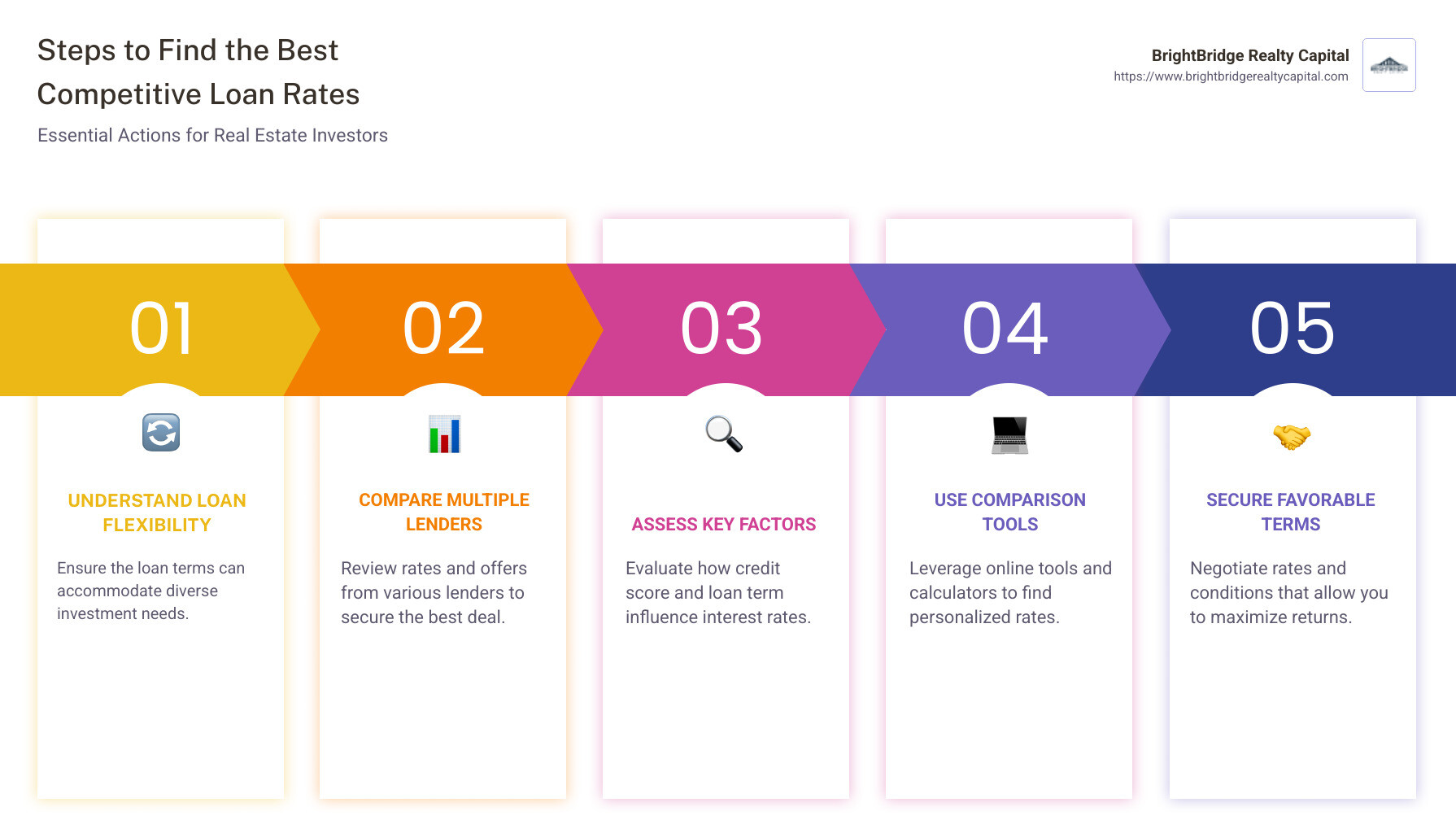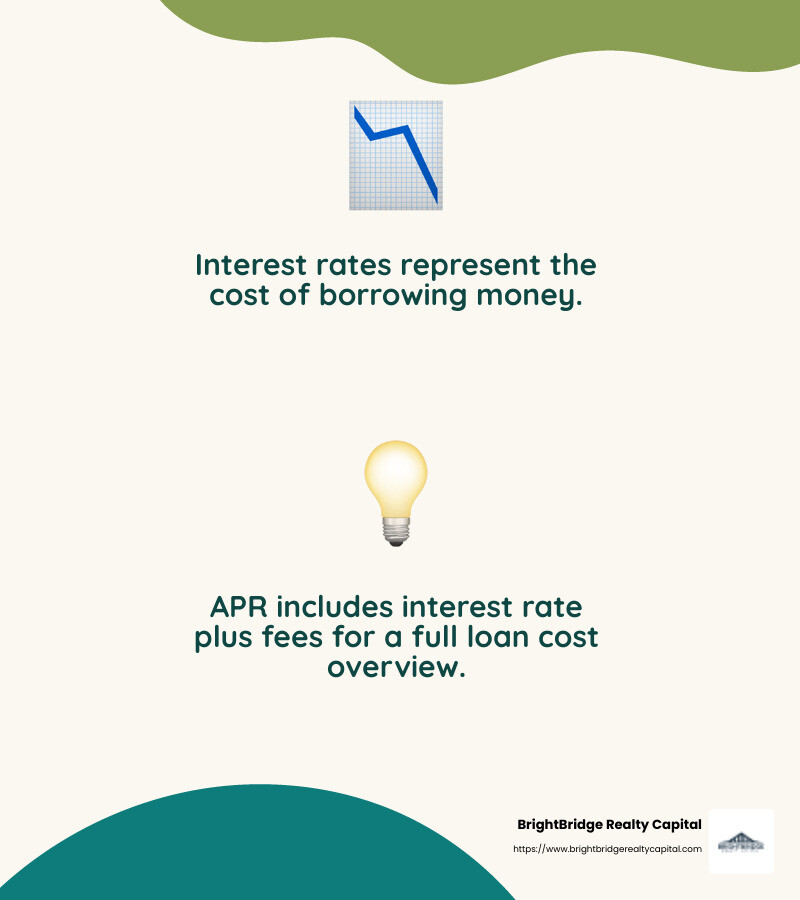Competitive Loan Rates: Your Guide to Finding the Best Deals

Competitive loan rates are crucial for real estate investors focused on expanding their rental portfolio or taking on fix-and-flip projects. Finding these rates can significantly impact your financial goals and investment success. To secure the most advantageous rates quickly, investors should:
- Prioritize loan flexibility to accommodate diverse investment needs.
- Compare rates from multiple lenders to ensure the best deal.
- Understand the key factors like credit score and loan term that influence rates.
In the world of real estate investing, access to competitive loan rates and fast loan processes is essential. Whether you're funding a new project or refinancing existing properties, securing favorable rates allows you to maximize returns and grow your investment portfolio confidently.
[ ]
]
Competitive loan rates terms to know:
Understanding Competitive Loan Rates
When you're exploring competitive loan rates, it's important to grasp a few key concepts: interest rates, APR, and your credit score. These elements are crucial in determining how much you'll pay over the life of a loan.
Interest Rates vs. APR
Interest rates are the cost of borrowing money, expressed as a percentage of the loan amount. They're a key part of any loan, but they don't tell the whole story. That's where the Annual Percentage Rate (APR) comes in. The APR includes not just the interest rate but also any fees or additional costs associated with the loan. This makes it a more comprehensive measure of a loan's total cost.

For instance, if you have a loan with a 7% interest rate and $10,000 in fees, your APR might be 7.227%. This higher percentage reflects the true cost of the loan, making it easier to compare different loan offers.
The Role of Your Credit Score
Your credit score is a critical factor in securing competitive loan rates. Lenders use it to assess your creditworthiness. A higher credit score typically means lower interest rates because it indicates you're less risky to lend to.
If your credit score needs improvement, it might be worth taking some time to boost it before applying for a loan. This can be done by paying off existing debts, ensuring all bills are paid on time, and checking your credit report for errors.
Why Competitive Loan Rates Matter
Securing the best loan rates can save you a lot of money over time. For real estate investors, especially, these savings can translate into higher returns and more capital to reinvest in other properties.
Understanding the full scope of loan costs through the APR, and knowing how your credit score affects your rate, puts you in a stronger position to negotiate better terms.
In the next section, we'll explore the factors influencing loan rates and how you can use this knowledge to your advantage.
Factors Influencing Loan Rates
When you're on the hunt for competitive loan rates, understanding what influences these rates can give you an edge. Let's explore three key factors: creditworthiness, loan amount, and loan term.
Creditworthiness
Your creditworthiness is a major player in determining your loan rate. Lenders look at your credit score, which is a reflection of your financial history. A higher score usually means you're a safer bet for lenders, and they reward that with lower interest rates.
If your credit score is less than stellar, don't worry! There are ways to improve it, like paying down debt and ensuring timely payments. Even a small boost in your credit score can lead to better loan offers.
Loan Amount
The size of your loan can also affect the interest rate. Generally, larger loans come with lower interest rates because they are more profitable for lenders. However, this isn't a hard and fast rule, and factors like your creditworthiness and the loan term also play a role.
Lenders may offer different rates for loans of varying amounts. For example, a loan amount between $5,000 and $100,000 might have a different rate range than a loan of $1,000 to $50,000. It's important to compare offers to find the best deal for your specific loan amount.
Loan Term
The loan term, or the length of time you have to repay the loan, is another critical factor. Shorter loan terms typically come with lower interest rates because the lender's risk is lower. Conversely, longer terms often have higher rates due to the increased risk over time.
For example, a 5-year loan might have a lower rate compared to a 30-year loan. But remember, while shorter terms mean less interest over time, they also come with higher monthly payments. It's all about finding the right balance for your financial situation.
By understanding these factors—creditworthiness, loan amount, and loan term—you can better steer the loan landscape. In the next section, we'll discuss how to find the best competitive loan rates using comparison tools and personalized rate offers.
How to Find the Best Competitive Loan Rates
Finding competitive loan rates doesn't have to be overwhelming. With a few handy tools and strategies, you can uncover the best deals custom to your needs.
Comparison Tools
First off, don't underestimate the power of comparison tools. These online platforms allow you to compare loan offers from different lenders side by side. By entering some basic information like your desired loan amount and term, you can quickly see which lenders offer the most favorable rates.
Comparison tools save you time and help you make informed decisions. They provide a clear picture of the market, enabling you to spot which lenders are offering the best deals.
Personalized Rates
Another key strategy is to look for personalized rates. Many lenders offer pre-qualification options that let you see what rate you might get without affecting your credit score. This is crucial because the rates you see advertised are often the best possible rates for top-tier borrowers.
By checking your personalized rate, you get a more accurate idea of what you can expect. This helps you avoid surprises down the road and ensures you're comparing apples to apples when evaluating loan offers.
Loan Calculators
Finally, make use of loan calculators. These tools allow you to input different loan amounts, terms, and interest rates to see how they'll affect your monthly payments and total cost over time.
Loan calculators are invaluable for planning your budget. They help you determine what loan terms are affordable for you and how changes in interest rates or loan amounts can impact your finances.
By leveraging comparison tools, personalized rates, and loan calculators, you can steer the loan landscape with confidence. Up next, we'll explore strategies for securing the best rates, including tips on credit improvement and discounts.
Top Strategies for Securing Competitive Loan Rates
Securing competitive loan rates can save you a lot of money over the life of your loan. Here are some top strategies to help you get the best rates possible.
Credit Improvement
Your credit score is a big factor in determining your loan rate. A higher score often means lower interest rates. Improving your credit score can be one of the most effective ways to secure a better rate. Here’s how you can boost your score:
- Pay your bills on time. Late payments can negatively impact your credit score.
- Reduce your debt. High credit card balances can lower your score, so aim to pay them down.
- Check your credit report for errors. Mistakes on your credit report can hurt your score, so review it regularly and dispute any inaccuracies.
Even a small increase in your credit score can lead to significant savings on loan interest over time.
Autopay Discounts
Many lenders offer autopay discounts. This means if you set up automatic payments from your bank account, you might get a reduced interest rate. This not only helps you save money but also ensures you never miss a payment, which can further protect your credit score.
Direct Deposit Discounts
Another way to secure a better rate is through direct deposit discounts. Some lenders offer additional rate reductions if you set up direct deposit with their banking services. To qualify, you usually need to set up direct deposit within a certain time frame after your loan is funded. This strategy not only helps you secure a lower rate but also streamlines your finances by ensuring your payments are made automatically.
By focusing on credit improvement and taking advantage of autopay and direct deposit discounts, you can position yourself to secure the most competitive loan rates available. Up next, we'll tackle some frequently asked questions about these rates, including what constitutes a good APR and how banks determine interest rates.
Frequently Asked Questions about Competitive Loan Rates
What is a good APR on a personal loan?
A good APR (Annual Percentage Rate) on a personal loan often falls between 6% and 36%, according to financial experts. Your credit score plays a crucial role in determining the APR you qualify for. Generally, a higher credit score can help you secure a lower APR, which means you'll pay less in interest over the life of the loan.
If your credit score is in the good range (670 to 739), you can typically expect to receive more favorable rates. On the other hand, if your score is lower, you might find yourself facing higher APRs. It's always a good idea to compare offers from multiple lenders to ensure you're getting the best possible rate.
How do banks set interest rates on loans?
Banks set interest rates based on several factors, including the rates set by the Federal Reserve and the rates offered by their competitors. The Federal Reserve influences the economy by adjusting the federal funds rate, which can impact the interest rates banks charge their customers.
Additionally, banks consider the borrower's creditworthiness, which includes their credit score, income, and financial history. They also look at the loan amount and loan term. Generally, longer-term loans might have slightly higher rates due to the increased risk over time.
Which types of loans typically have the lowest rates?
Certain types of loans are known for having lower interest rates. Mortgage rates and auto loan rates are typically among the lowest. This is because these loans are secured by collateral (your home or car), which reduces the lender's risk.
Mortgage rates can vary widely based on the loan type, such as fixed-rate or adjustable-rate mortgages. Auto loans also have competitive rates, especially if you have a good credit score and make a substantial down payment.
Securing the best competitive loan rates often requires shopping around, understanding your credit profile, and leveraging any discounts or offers available.
Conclusion
At BrightBridge Realty Capital, we pride ourselves on offering customized solutions designed to meet the unique needs of real estate investors nationwide. Whether you're flipping properties, building new constructions, or growing a rental portfolio, our goal is to provide the most competitive loan rates custom to your specific investment strategy.
One of our standout features is our commitment to fast closings—often within a week. This speed ensures you can seize opportunities as they arise without unnecessary delays. By cutting out intermediaries, we offer a seamless process that allows you to focus on what truly matters: growing your investment portfolio.
Our direct lending approach means you benefit from competitive rates and a hassle-free experience. We understand that every investor's strategy is unique, and our flexible funding solutions are designed to keep your projects on track and your investment strategy moving forward.
Find how our custom financing solutions can help you achieve your real estate goals. Explore our loan options today and experience the BrightBridge difference.



